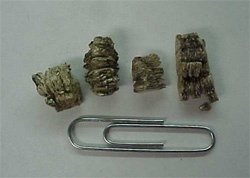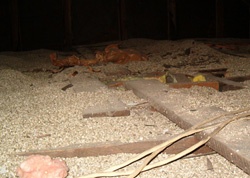WHAT IS VERMICULITE?
HAMILTON HVAC/ AIR DUCT CLEANING COMPANY
Vermiculite is a naturally occurring mica-like mineral that has the unusual property of expanding into worm-like accordion-shaped pieces when heated.
The treated vermiculite becomes a lightweight, fire-resistant, absorbent, and odorless material. These properties allow vermiculite to be used to make numerous products, including Vermiculite Attic Insulation in Hamilton. Vermiculite attic insulation is a pebble-like, poured-in material and is usually light brown to gold in color. Sizes of vermiculite products range from very fine particles to large (coarse) pieces nearly an inch long. It is most commonly found as Vermiculite Attic Insulation in Hamilton, but can also be found in exterior wall cavities of certain types of construction. It is also common to find vermiculite as loose fill insulation in outside wall cavities, including concrete block walls, especially on commercial builds.





